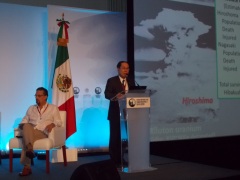 Alan Robock at the podium in Nayarit, describes climate impact of a nuclear war.
Alan Robock at the podium in Nayarit, describes climate impact of a nuclear war.The head of the Civilian Protection division of Mexico’s Ministry of the Interior destroyed Mexico City after lunch yesterday. Which is to say, he conducted a classic IPPNW “bombing run,” showing the overwhelming casualties, physical destruction, and radiation effects of a nuclear detonation over this country’s capital. And if anyone didn’t draw this conclusion for themselves, he confirmed that neither his agency nor anyone else would have the resources to help the surviving victims of such a catastrophe.
Alan Robock, IPPNW’s principal science adviser on the climate effects of nuclear war, used his brilliant animations to show how the smoke and soot from less than one percent of existing arsenals would block sunlight from the Earth and disrupt agricultural production for a decade, and how a major war using the still-enormous arsenals held by the US and Russia would be…well…the end of the world.
Alan also reminded the conference, however, that Ronald Reagan and Mikhail Gorbachev both credited the scientists who first studied nuclear winter for influencing their decisions to drastically cut the US and Soviet arsenals during the Cold War, and he expressed the hope that politicians would pay attention to this new science and make even better policy decisions.
 Masao Tomonaga
Masao Tomonaga Ira Helfand
Ira HelfandIPPNW had a very big footprint on the first day in Nayarit. Masao Tomanaga presented a new study comparing the consequences of the 1945 Hiroshima bombing with what would happen should one of today’s weapons be used against this largely recovered and thriving city. It was a sobering reminder of what is sure to happen to some city, somewhere, if we don’t finish this job.
Which led to Ira Helfand, who closed the presentations for the day in powerful form. Ira’s slides didn’t work, which turned to his favor, because everyone in the room was riveted by his words rather than trying to make sense out of dots and circles and data on charts, which will all be uploaded to the conference website anyway.
The video is on our YouTube channel, and you should watch it. Here’s the spoiler: in his conclusion, Ira likened the nuclear-armed states to the drunk drivers who show up badly injured in his hospital, and who had been in total denial, convinced that they were in control and that nothing like this could ever happen. “Friends don’t let friends drive drunk is the saying, and maybe friends don’t let friends have nuclear weapons. Go talk to your friends.” (That’s a paraphrase—watch the video.)
 IPPNW Co-president and ICAN Co-chair Tilman Ruff asks the panelists a question at the close of a working session.
IPPNW Co-president and ICAN Co-chair Tilman Ruff asks the panelists a question at the close of a working session.Liv Torres of ICAN partner Norwegian People’s Aid asked the question of the day. During a civil society comment at the close of the evening, she observed that the facts about the humanitarian impact of nuclear weapons were compelling, and asked the assembled delegations: “What are you going to do about it?” Perhaps we’ll start to hear some answers today.